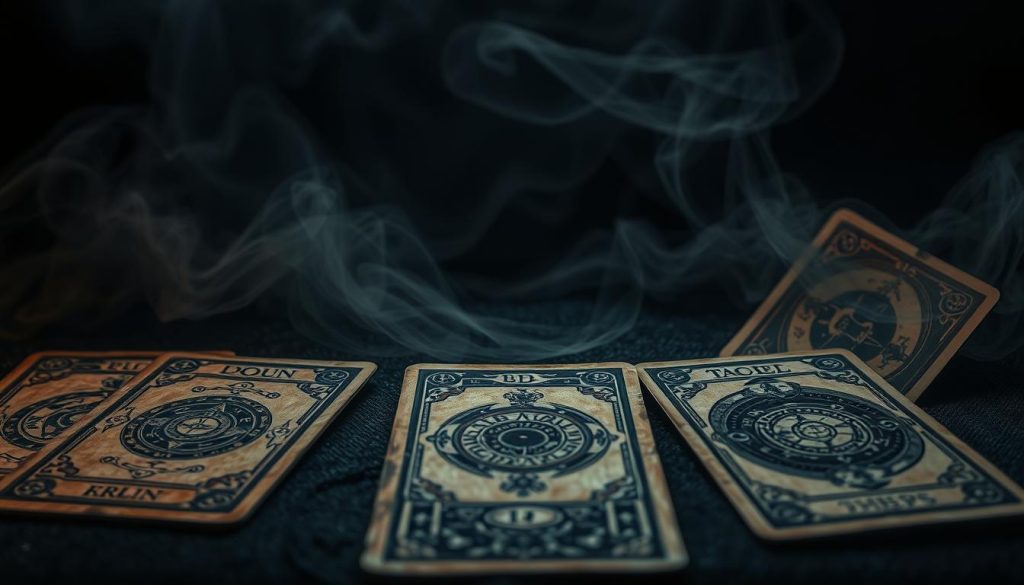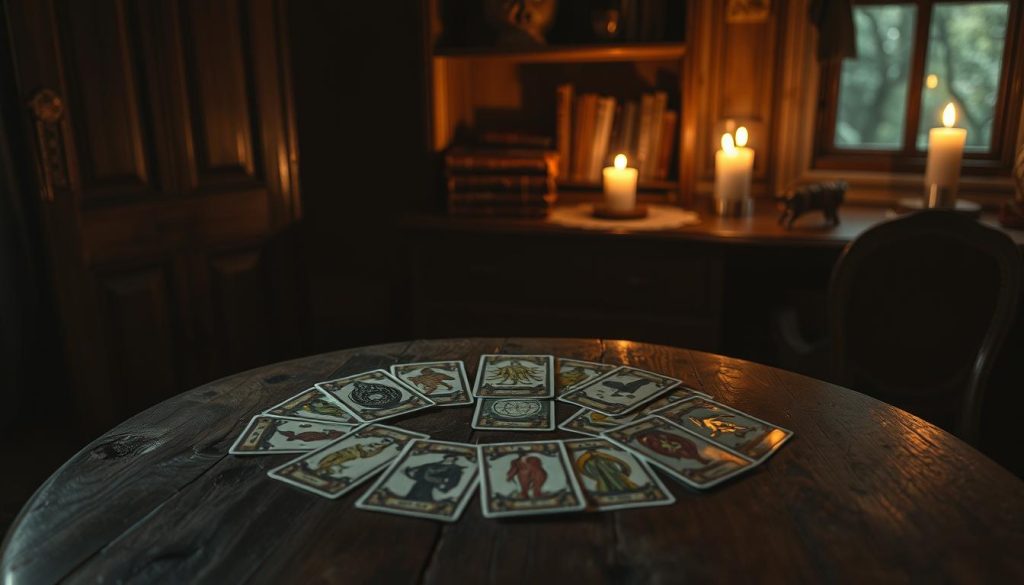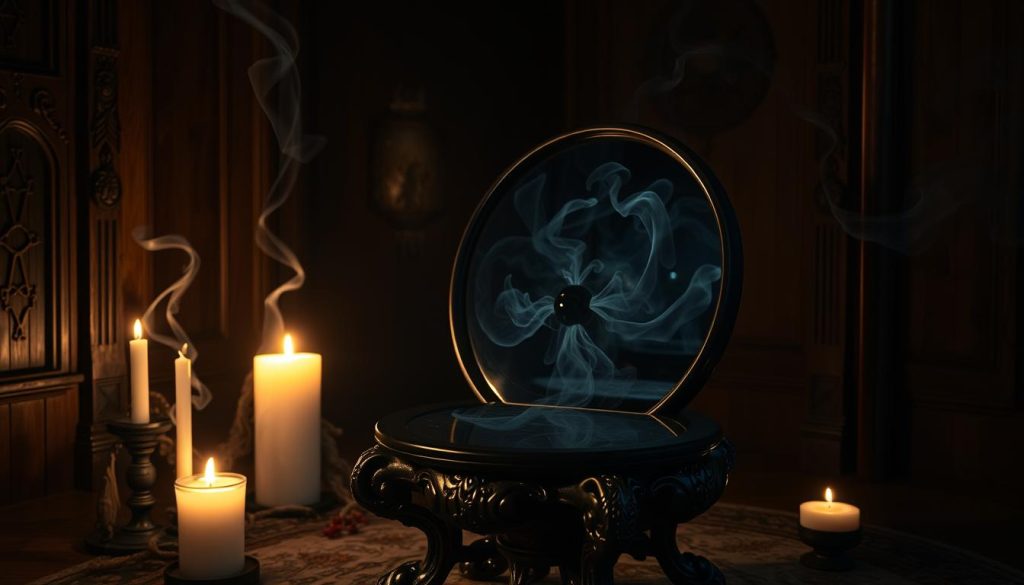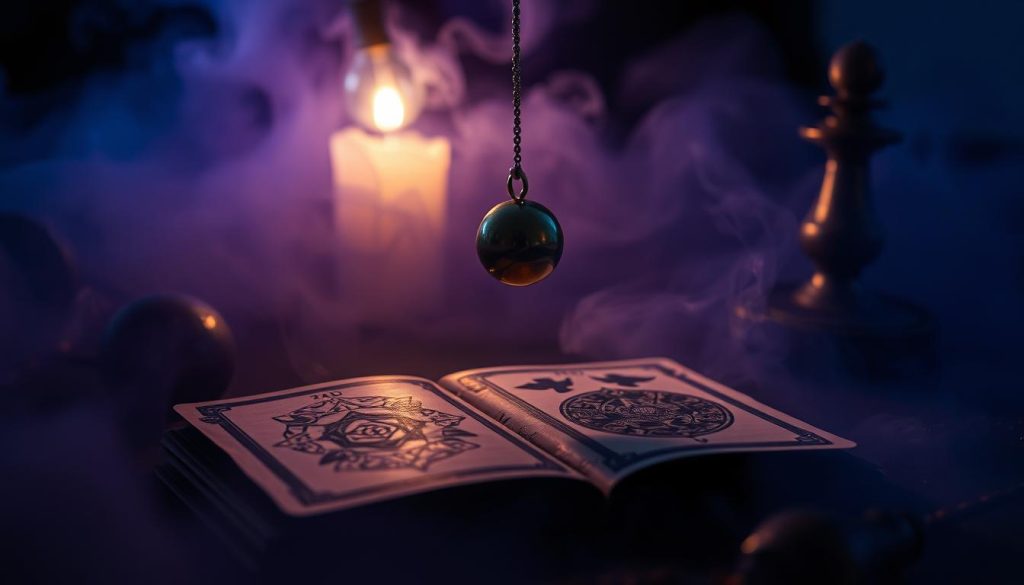Welcome. We’re opening the temple doors to simple practices that add a little wonder to daily life. This intro invites you to playful study, not heavy rites.
We’ll cover classic divination allies like tarot cards, pendulums, runes, scrying mirrors, and cozy tea leaf reading. Each item is a small bridge to inner connection and clear, calm insight.
Expect gentle steps you can try tonight. Our aim is practical guidance that fits modern rhythms. We’ll show ways these tools support your practice, and how they can shape everyday life with meaning.
Ready to peek behind the veil? We move as co-explorers, turning curiosity into steady ritual and playful discovery.
Unlocking the Veil Today: How Divination Tools Elevate Your Practice
Imagine tools that translate symbols and patterns into usable guidance for daily life. These little helpers act as bridges between a quiet feeling and a clear next step.
Cards show archetypal images that spark stories. A pendulum answers by shifting with subtle energy. Scrying and tasseomancy ask us to notice shapes and symbols, while runes add position and direction to meaning.
We teach a simple way to pair felt-sense intuition with repeatable methods. Breathe, set intention, then ask focused questions. This calms the field and sharpens the signal you receive.
Practical tip: pick a single method for a week, track results, then refine. That practice reduces noise, focuses attention, and turns fuzzy hunches into useful prompts.
Expect examples soon of when to reach for each method so you can move through life with more ease. We invite gentle testing and steady rhythms that fit your day — not some distant someday.
Esoteric Tools Every Mystic Needs: Tarot Decks, Pendulums, and More
A well-chosen set makes practice simple: one deck for stories, one instrument for quick answers, and a mirror for deeper seeing.
Start with the classic structure: many decks follow the Rider‑Waite‑Smith format of 78 cards—22 Major Arcana for life’s big themes and 56 Minor Arcana for everyday choices. This split helps a practitioner map mythic beats and daily details with ease.
Pick a deck whose art and symbolism light you up. When imagery resonates, use becomes steady. That steady use is how personal growth shows up.
Pendulums come in crystal, metal, and wood. Each material feels different in the hand and moves with clear, directional language for fast yes/no readings.
Round out the kit with runes for crisp answers, a dark mirror for visionary work, a cozy cup for playful leaf readings, and an astrology chart to spot timing and patterns. We encourage blending methods depending on the question—sometimes detail; sometimes swift clarity.

What Are Divination Tools and How Do They Work?
Divination instruments translate quiet impressions into clear, usable guidance. We define a divination tool as something that converts subtle insight into a structured answer. Some work with symbols. Others respond to felt energy or images in a cup.
Meanings come from placement, orientation, and context. A card’s spot in a spread matters. A rune flipped backward alters tone. A pendulum’s swing answers a focused question.
Calm focus affects the result. When we breathe and steady, energy reads more cleanly. That clarity helps intuition speak through the object.
Phrase your question with care. Precise prompts bring cleaner signals. Then record sessions in a journal. Over time patterns build understanding and deepen your connection.
Remember: these aids don’t fix fate. They illuminate options, timing, and next steps. Blend traditional guide meanings with what your body notices. Your imagination completes the message.
Tarot Cards: Iconic Archetypes for Deep Reading
A full 78-card system gives us a compact atlas for inner stories and daily decisions.
A standard set has 78 cards: 22 major arcana and 56 minor arcana in four suits—Cups, Pentacles, Swords, Wands. The majors show life chapters. The minors map small scenes and emotions.
Start simple. Try a three-card spread for past/present/future, then explore the Celtic Cross for depth. Watch how symbolism links across cards to form a story.
Choose a deck that resonates. Rider‑Waite‑Smith is a classic foundation. Modern art-forward sets work when imagery sparks your intuition.
Care and cleansing matter. Use moonlight, smoke, or mindful shuffling between sessions. Keep a journal of readings and meanings to spot patterns over time.
Practical tip: blend book meanings with your gut hits. Close each session with gratitude to clear energy and anchor insight for grounded action.

Pendulums: Straightforward Yes/No Answers on a Chain
For quick clarity, few devices beat a pendulum held steady in the hand. A pendulum is a weighted charm on a chain; it gives clear motion for simple prompts.
How it works: small swings often map to answers — clockwise for yes, counterclockwise for no, circular or stillness for review. We suggest you set intention, program your directions, then ask neutral questions.
Choose a piece that feels right. A crystal offers resonance, metal gives precision, wood brings grounding. Hold the chain with a relaxed grip; steady your elbow and breathe before you begin.
Start with calibration: ask a known question until the motion is consistent. Log results in a journal to track accuracy. Cleanse with sunlight or a quick smudge; store wrapped to protect energy.
Use the mini flow: breathe, ask one focused yes questions, note motion, record insight. With ten calm sessions, you’ll find the rhythm that makes pendulums reliable companions for everyday choice.
Scrying Mirrors: Gaze, Receive, and Record
A dark mirror invites quiet images when the room is soft and still.
Set the scene: low light, a black mirror at eye level, and a seat that keeps your posture relaxed. Breathe deeply. Soften your gaze until shapes, scenes, or symbols float up without forcing them.
Let intention be light. Ask a simple question and wait. This practice helps quiet the mind so intuition can surface with clearer meanings.

Record what you see right after a reading. Jot images, emotional tone, and any repeated signs. Over time patterns reveal guidance about life and timing.
Short sessions work well on busy days. Try five to ten minutes to keep connection warm. Notice repetition, strong feeling, or synchronicities—those clues help you tell imagination from message.
Close with care: cover the mirror, offer thanks, and take a moment to ground. This tidy ritual leaves you clear, centered, and ready to return.
Runes: Ancient Symbols of Wisdom and Guidance
Runes offer compact symbols that speak plainly when we ask simple questions. A typical set has 24 marks, each with a traditional meaning and a living presence in a reading.
Use a single draw for focused answers. Try three-runer spreads for context. Or cast a handful onto a cloth for a broader map. Position, proximity, and orientation change the tone of each sign.
Key runes to know: Fehu suggests wealth or resources. Uruz hints at strength. Berkana points to growth. Combine these classic meanings with what your body senses for clearer understanding.
Keep sessions short at first. Cleanse with smoke or sun, store wrapped, and pull one rune each morning to track patterns. Journal pairings and repeated symbols to spot life themes.
As practitioners, we personalize associations while honoring core tradition. That balance builds reliable divination practice and steady growth in insight.
Tea Leaf Reading: Brew Intuition with Tasseomancy
Tea leaf reading invites slow attention: brew loose-leaf tea, sip with intention, then leave a small amount in the cup.
Swirl the cup clockwise in your hand, invert it on a saucer, and let the leaves settle. Shapes near the rim point to near-future or current themes. Marks at the bottom suggest deeper influences or long arcs of life.
Common symbols—animals, letters, simple objects—carry classic meanings. We blend those guides with our own intuition to find clear, personal answers. Ask one focused question before you drink for cleaner signals.
Keep a reading journal. Note images, placement, and how they play out over time. For shared sessions, use gentle prompts and take turns noting impressions for a playful, supportive vibe.
Practical tips: pick a rounded cup, low tannin teas for clearer shapes, and soft light for easy viewing. Close with a short gratitude moment and a tidy cleanup to leave the space light for your next divination session.
Astrology Charts: Mapping the Stars for Insight
An astrology chart turns birth data into a clear map you can read for timing and life themes.
Start with three essentials: birth date, exact birth time, and location. Plug these into a chart generator, then view planets across 12 signs and 12 houses.
Read the landscape: planets show energies, houses show life areas. Aspects—angles between planets—reveal tension or flow and explain events and opportunities ahead.
Transits compare current planetary motion to your natal map. Use transits for timing: plan launches, rest, or reflection windows with more ease about the future.
Focus first on Sun, Moon, and Rising. These three signs anchor identity, emotional tone, and outward style—fast hooks for any reading.
Practical guide: map chart notes to habits for steady personal growth. Pair chart insights with card readings for richer narrative plus precise timing.
We offer a gentle reading flow: generate the chart, note key aspects, check transits for time-sensitive events, then journal findings. This process builds deeper understanding and ongoing divination practice.
Pendulum vs Tarot: Choosing the Right Tool for Your Question
Choosing between a short swing and a full spread depends on the shape of your question.
Pendulums excel for fast, binary checks. Use a pendulum when you need crisp yes/no/maybe responses or a quick energy read on a simple choice.
Tarot shines when a situation needs story, nuance, and timing. Pull cards to map layers: motives, influences, and possible outcomes over weeks or months.

Here’s a tidy decision flow: if the question is binary, ask the pendulum. If it has many factors—relationships, timing, or motives—turn to cards for depth. Then use the pendulum to confirm a next micro-step.
Example: for compatibility, a pendulum gives a quick yes or no about immediate chemistry. A card spread reveals timing and underlying dynamics, like “not now, potential in six months.”
Practical hacks: keep questions narrow. Avoid emotionally loaded phrasing. If a reading feels mixed, rephrase into smaller parts and retest. Close with a journal entry so guidance stays clear and usable.
From Selection to Practice: Caring for Your Tools and Building Skill
Small rituals keep your pieces responsive and your readings clear. Choose a deck and a crystal that fit your hands and your style. Notice how a deck shuffles, how a pendulum swings, and how a mirror sits in the room.
Cleansing is simple: moonlight, smoke, and intentional shuffling refresh cards and restore energy. For crystal pendulums, use water-safe methods only when appropriate, or opt for smoke or moonlight to recharge more delicate stones.
Program your pendulum motions with calm calibration. Ask a known yes/no question until the swing is consistent. This improves reliability over time.
Journal every session. Log the cards you pull, small meanings you discover, and patterns in Minor Arcana draws. Short notes compound into deep insight and steady personal growth.
Try a weekly plan: three short sessions of five to ten minutes. Rotate focus—one day cards, one day crystal checks, one day scrying or leaves. Close each reading with gratitude to seal the connection and keep your space bright.
Over time, these small steps save time and build skill. For extra support between sessions, visit mysticbolt.com for free apps and gentle prompts to keep your practice humming.
Step Into the Mystical Now: Try a Spread, Ask a Question, Begin
Take one strong, simple step now: pull a three-card spread, ask a clear question, and notice the first images your cards offer.
Calibrate your pendulum with a known yes/no, cast a single rune for the day, or do a short scry in dim light. Brew loose-leaf tea after dinner for a quick tea leaf reading and jot what stands out.
Pair methods when you like: use a tarot narrative to map context, then use a pendulum to confirm the next micro-step. Keep a light journal of readings to track patterns over time.
Cleanse with moonlight, smoke, or intention. Choose materials that feel right in your hand—crystal, metal, or wood—and play with gentle, steady practice for clearer guidance.
Ready for a boost? Visit mysticbolt.com for free readings and gentle tools to support your divination practice. Ask one question, breathe, and let answers arrive at their own pace.
